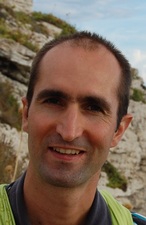4th session, February 24th & 25th 2014
Monday 24
9h15 - 9h45 : Coffee (room 9)
9h45 - 10h45 : Didier Smets (UPMC)

Sur l'interaction des fronts stationnaires dans les systèmes gradients
Nous discuterons de la relaxation vers des chaines de fronts stationnaires dans les systèmes de réaction-diffusion gradients en une variable d'espace. Nous présenterons plus en détails deux résultats : le premier concerne une borne supérieure sur la loi d'interaction dans le cas des systèmes, le deuxième qui décrit précisément la loi dans le cas scalaire dégénéré. Il s'agit de travaux en collaboration avec Fabrice Béthuel et, pour partie d'entre eux, avec Giandomenico Orlandi.
Nous discuterons de la relaxation vers des chaines de fronts stationnaires dans les systèmes de réaction-diffusion gradients en une variable d'espace. Nous présenterons plus en détails deux résultats : le premier concerne une borne supérieure sur la loi d'interaction dans le cas des systèmes, le deuxième qui décrit précisément la loi dans le cas scalaire dégénéré. Il s'agit de travaux en collaboration avec Fabrice Béthuel et, pour partie d'entre eux, avec Giandomenico Orlandi.
11h - 12h : Thomas Giletti (Université de Lorraine)

Convergence to KPP travelling waves
A central issue in the study of propagation phenomena arising in reaction-diffusion equations is the relationship between traveling waves and the large time behavior of solutions of the Cauchy problem. For instance, for a KPP type nonlinearity, solutions with compactly supported initial data spread with the speed of the minimal travelling wave. In this talk, I will focus on the issue of the convergence of the whole shape of these solutions to that of the travelling wave with minimal speed. In particular, I will discuss on the extensions, in the heterogeneous framework, of some classical arguments that lead back to the seminal paper of Kolmogorov-Petrovsky-Piskunov.
A central issue in the study of propagation phenomena arising in reaction-diffusion equations is the relationship between traveling waves and the large time behavior of solutions of the Cauchy problem. For instance, for a KPP type nonlinearity, solutions with compactly supported initial data spread with the speed of the minimal travelling wave. In this talk, I will focus on the issue of the convergence of the whole shape of these solutions to that of the travelling wave with minimal speed. In particular, I will discuss on the extensions, in the heterogeneous framework, of some classical arguments that lead back to the seminal paper of Kolmogorov-Petrovsky-Piskunov.
14h - 15h : Joy Zhou (MBI, Ohio State University)

Range shifts under climate change: what will accelerated warming do?
Rapid climate warming has caused species across the globe to shift their geographic ranges poleward in latitude or upward in elevation. We naturally ask: will species be able to keep up with climate warming? To answer this question, I considered a mathematical model for a single-species population with distinct growth and dispersal stages.
The model is based on an integrodifference-equations framework, and is thus able to accommodate a diverse assortment of dispersal mechanisms. I incorporated climate warming by letting the niche curve, a curve describing environmental suitability for population growth on a spatial gradient, shift in one direction. The equation thus becomes non-autonomous. This equation can prescribe climate-warming scenarios and environmental heterogeneity in a versatile way. I compared different warming scenarios, and in this talk I will show that acceleration of climate warming imposes extra burden on the species compared with constant-speed warming, even if the amount of warming is the same over the same period of time. There is also a bifurcation phenomenon in this problem: under constant-speed warming, the population may fail to persist, and go extinct, if climate warming is too rapid. The threshold speed for persistence, or the critical speed, can be viewed as the species’ ability to keep up with climate warming. I will show that this critical speed depends both on the species’ growth and its dispersal.
Rapid climate warming has caused species across the globe to shift their geographic ranges poleward in latitude or upward in elevation. We naturally ask: will species be able to keep up with climate warming? To answer this question, I considered a mathematical model for a single-species population with distinct growth and dispersal stages.
The model is based on an integrodifference-equations framework, and is thus able to accommodate a diverse assortment of dispersal mechanisms. I incorporated climate warming by letting the niche curve, a curve describing environmental suitability for population growth on a spatial gradient, shift in one direction. The equation thus becomes non-autonomous. This equation can prescribe climate-warming scenarios and environmental heterogeneity in a versatile way. I compared different warming scenarios, and in this talk I will show that acceleration of climate warming imposes extra burden on the species compared with constant-speed warming, even if the amount of warming is the same over the same period of time. There is also a bifurcation phenomenon in this problem: under constant-speed warming, the population may fail to persist, and go extinct, if climate warming is too rapid. The threshold speed for persistence, or the critical speed, can be viewed as the species’ ability to keep up with climate warming. I will show that this critical speed depends both on the species’ growth and its dispersal.
Tuesday 25
9h15 - 9h45 : Coffee (room 9)
9h45 - 10h45 : Didier Smets (UPMC)

Suite de l'exposé
11h - 12h : Adrien Blanchet (Université de Toulouse)

Applications du transport optimal dans les jeux à potentiel
On s'intéressera à une situation dans laquelle les agents doivent décider où habiter lorsqu'ils arrivent dans une nouvelle ville. L'agent peut, par exemple, vouloir s’installer plutôt en centre ville parce que c'est l'endroit d'où il aura, en moyenne, le moins de chemin à parcourir pour interagir avec ses futurs relations. Par contre il faut aussi prendre en compte le fait qu'en centre ville, la compétition est plus grande et donc les appartements plus petits ou plus chers.
Mathématiquement, On considère un jeu non-coopératif, non-atomique, anonyme avec un continuum de joueurs. Mathématiquement, soient l'espace $X$ du type des agents, l'espace $Y$ des actions et un coût $c(x,y)$ qui mesure le coût d'un agent de type $x$ à prendre une action $y$. La distribution du type des agents $\mu \mathcal P(X)$ étant donné, un agent de type $x$ qui entreprend une action $y$ paie le coût $\Gamma(x,y, \lambda)$ où $\lambda$ est la distribution des actions de l'ensemble des joueurs.
La question est de déterminer l'"équilibre" de Nash (= la situation dans laquelle personne n'a intérêt à déménager). Dans une situation très schématique, il est possible de déterminer les équilibres, en utilisant les derniers développements de la théorie du transport optimal.
En fait on prouve, sous des conditions assez générales, qu'il existe un unique équilibre et qu'il peut être vu comme le minimiseur de la fonctionnelle :
\begin{equation*}
\J_\mu[\nu]:=\W_c(\mu, \nu)+ \E[\nu]
\end{equation*}
où $\W_c(\mu, \nu)$ est la distance de Monge-Kantorovich entre $\mu$ et
$\nu$ pour le coût $c$ et $\E$ est typiquement de la forme
\begin{equation*}
\E[\nu]:= \int_{\C}V[\nu(x)]\dd y+\int_{\C}A(y)\lambda(y)\dd
y+\frac{1}{2}\iint_{\C\times\C}\phi(y-z)\lambda(y)\lambda(z)\dd y\dd z /;.
\end{equation*}
La fonctionnnelle n'est pas convexe au sens classique mais elle l'est le long des géodésique généralisées au sens du transport optimal. Nous caractérisons les équilibres en terme d'une équation de Monge-Ampère qu'il est possible de les simuler numériquement en 1d. On calcule aussi les taxes qui permettent de rétablir l'efficacité du jeu. On introduit pour finir la dynamique type "descente de gradient dans la métrique de Monge-Kantorovich" associée à ce problème.
Références :
* A. Blanchet, P. Mossay & F. Santambrogio,
Existence and uniqueness of equilibrium for a spatial model of social
interactions. Pre-print, 2012.
* A. Blanchet & G. Carlier, Optimal transport and Cournot-Nash
equilibria. Preprint, 2012.
On s'intéressera à une situation dans laquelle les agents doivent décider où habiter lorsqu'ils arrivent dans une nouvelle ville. L'agent peut, par exemple, vouloir s’installer plutôt en centre ville parce que c'est l'endroit d'où il aura, en moyenne, le moins de chemin à parcourir pour interagir avec ses futurs relations. Par contre il faut aussi prendre en compte le fait qu'en centre ville, la compétition est plus grande et donc les appartements plus petits ou plus chers.
Mathématiquement, On considère un jeu non-coopératif, non-atomique, anonyme avec un continuum de joueurs. Mathématiquement, soient l'espace $X$ du type des agents, l'espace $Y$ des actions et un coût $c(x,y)$ qui mesure le coût d'un agent de type $x$ à prendre une action $y$. La distribution du type des agents $\mu \mathcal P(X)$ étant donné, un agent de type $x$ qui entreprend une action $y$ paie le coût $\Gamma(x,y, \lambda)$ où $\lambda$ est la distribution des actions de l'ensemble des joueurs.
La question est de déterminer l'"équilibre" de Nash (= la situation dans laquelle personne n'a intérêt à déménager). Dans une situation très schématique, il est possible de déterminer les équilibres, en utilisant les derniers développements de la théorie du transport optimal.
En fait on prouve, sous des conditions assez générales, qu'il existe un unique équilibre et qu'il peut être vu comme le minimiseur de la fonctionnelle :
\begin{equation*}
\J_\mu[\nu]:=\W_c(\mu, \nu)+ \E[\nu]
\end{equation*}
où $\W_c(\mu, \nu)$ est la distance de Monge-Kantorovich entre $\mu$ et
$\nu$ pour le coût $c$ et $\E$ est typiquement de la forme
\begin{equation*}
\E[\nu]:= \int_{\C}V[\nu(x)]\dd y+\int_{\C}A(y)\lambda(y)\dd
y+\frac{1}{2}\iint_{\C\times\C}\phi(y-z)\lambda(y)\lambda(z)\dd y\dd z /;.
\end{equation*}
La fonctionnnelle n'est pas convexe au sens classique mais elle l'est le long des géodésique généralisées au sens du transport optimal. Nous caractérisons les équilibres en terme d'une équation de Monge-Ampère qu'il est possible de les simuler numériquement en 1d. On calcule aussi les taxes qui permettent de rétablir l'efficacité du jeu. On introduit pour finir la dynamique type "descente de gradient dans la métrique de Monge-Kantorovich" associée à ce problème.
Références :
* A. Blanchet, P. Mossay & F. Santambrogio,
Existence and uniqueness of equilibrium for a spatial model of social
interactions. Pre-print, 2012.
* A. Blanchet & G. Carlier, Optimal transport and Cournot-Nash
equilibria. Preprint, 2012.
15h - 16h : CAMS seminar
